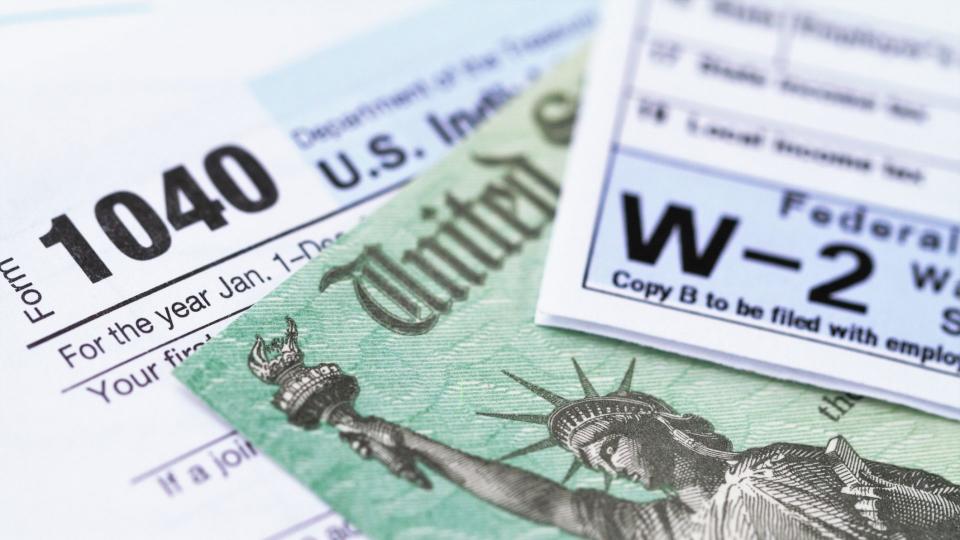3 Big Reasons You Could See a Smaller Tax Refund This Year

If you’ve gotten sizable tax refunds in the past few years and are expecting the same in 2023, you might want to prepare for some bad news. For many Americans, tax refunds in 2023 will be much smaller than in 2022, or even in 2021.
See the List: 8 IRS Secrets To Know for the 2023 Tax Filing Season
Discover: 3 Signs You’re Serious About Raising Your Credit Score
The reason for this isn’t because tax rates have gone up. Instead, it’s due to various payments, credits and deductions that may have boosted your tax refund in prior years vanishing in the current tax year. All other things being equal, this means that your refund may shrink — or your tax liability might increase. Here are the major reasons why.
No Stimulus Payments
One of the first steps the U.S. government took in response to the coronavirus pandemic in 2020 was to authorize direct stimulus payments to Americans. The first round of these payments went out in Apr. 2020, the second round was issued at the end of 2020 and the third payments arrived in Mar. 2021. Americans who didn’t receive the payments directly could claim them on their 2020 and 2021 tax returns.
But for tax year 2022, no stimulus payments were issued. As the three prior rounds of payments ranged from $600 to $1,400 per person, many Americans received significant tax refunds, or at least reductions in their tax liabilities, in tax years 2020 and 2021. However, if you were relying on those payments in tax year 2022, you’re out of luck.
Take Our Poll: What Do You Plan To Use Your Tax Refund For?
Reduction in Expanded Pandemic Tax Credits
In addition to the coronavirus stimulus payments, various child-oriented tax credits received major boosts as well. The maximum amount of the Child Tax Credit, for example, was raised from $2,000 per child age 6 to 17 to $3,000 — and to $3,600 for children under age 6. For the first time ever, it was also extended to families who paid no federal income tax.
However, those credits have fallen back to their pre-pandemic levels as of tax year 2022. Now, the Child Tax Credit is limited to $2,000, with no more than $1,500 of that being refundable.
A small change was also made in the Earned Income Tax Credit for 2022. Whereas those under the income threshold and with no qualifying children could have earned a maximum of $1,502 in 2021, that limit has fallen back to $560, closer to pre-pandemic levels.
Meanwhile, the Child and Dependent Care Credit, which saw limits rise to as much as $8,000 during the pandemic, now has a limit of just $3,000 for one qualifying individual, or $6,000 for two or more.
All-in-all, lower-income families, especially those with children, received big boosts in their potential credits during the heart of the pandemic. As of 2022, however, those have rolled back. If you were used to receiving them in prior years, you should prepare for a potentially lower refund on your 2022 tax return.
Elimination of Special Pandemic-Era Charitable Deduction
Historically, charitable deductions must be itemized in order for taxpayers to benefit. However, in response to the coronavirus pandemic, that law was changed for both 2020 and 2021. In both of those pandemic-era years, taxpayers were allowed to take a $300 deduction for charitable donations — $600 for married couples — even if they didn’t itemize. The intention behind this change was to help ensure charities continued to receive funding even when Americans were struggling economically.
But this special deduction was eliminated in tax year 2022. So if you made a charitable contribution in 2022 but won’t be itemizing when you file your taxes, you will no longer be able to take a deduction, potentially resulting in a smaller refund.
The Bottom Line
Many American will see lower refunds when they file their tax year 2022 returns in 2023, but it’s not due to increases in tax rates. In fact, as the income required to trigger a higher tax bracket rose in 2022, as it traditionally does every year, those who earned the same amount of money in 2022 as they did in 2021 might actually find themselves in a lower tax bracket.
However, some significant credits, deductions and payments were eliminated or reduced in 2022. If you were among those who benefited from them the most in 2020 and 2021, you might face a smaller tax refund when you file your 2022 return.
More From GOBankingRates
This article originally appeared on GOBankingRates.com: 3 Big Reasons You Could See a Smaller Tax Refund This Year
